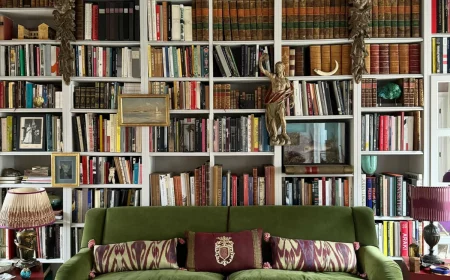Your Living Room Feels Off? Here’s the Pro-Level Fix (It’s Not About Buying More Stuff)
I’ve walked into hundreds of living rooms over the years. Some were massive, others were tiny. But the ones that just felt right all had a secret sauce in common. And it wasn’t about having the most expensive furniture or chasing the latest trend. It was all about understanding space, light, and how people actually move around in a room. A truly successful living room refresh goes way deeper than just swapping out pillows or slapping on a new coat of paint. It’s about rethinking the room from the bones out.
In this article
So many people tell me they feel stuck. They know something is off with their living room, but they can’t quite put their finger on it. They try moving a chair, buying a new lamp, maybe adding a few more decorations, but the room just ends up feeling more cluttered, not more comfortable. The secret isn’t adding more stuff. It’s about understanding the core principles that make a room work beautifully. Let’s break down how you can use these pro-level ideas in your own space.
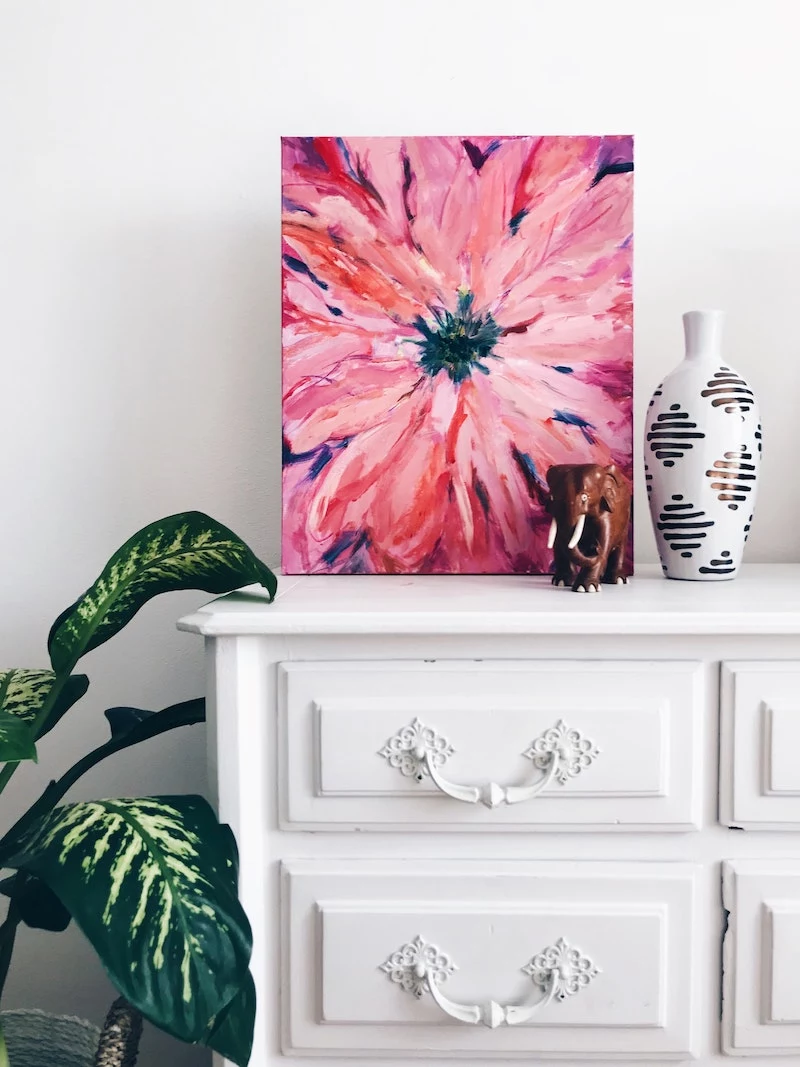
The Foundation: Figuring Out Your Room’s Natural Flow
Before you even think about touching a single piece of furniture, you have to understand how you move through the space. We call these “traffic patterns” or “desire lines” in the biz. They’re basically the invisible pathways people take to get from one spot to another. Think about it: the path from the hallway door to the sofa, or from the sofa to the kitchen. If the corner of a coffee table juts into that path, people are going to be bumping into it constantly. It’s a subtle thing that makes a room feel frustrating and just plain wrong.
Map Your Traffic Paths (It’s Easier Than It Sounds)
This is a simple but super powerful exercise. Seriously, it should only take you about 20 minutes. Just grab a piece of paper and sketch a rough layout of your living room, including doors, windows, and the fireplace. Now, draw lines for the most common trips:

- From the main entrance to the couch.
- From the seating area to other exits (like a patio door or hallway).
- To a bookshelf, a window, or anywhere else you go often.
These lines are your main traffic lanes. The gold standard is to keep these pathways at least 30 to 36 inches wide. Anything less starts to feel cramped and creates bottlenecks, especially when you have company over. Once you see these lines on paper, you’ll have a “eureka!” moment. You’ll finally understand why that one armchair has always felt like it’s in the way.
A Quick Word on Heavy Lifting
Heads up! Before you start rearranging, please be careful. I once got a call from a client who tried to redo his entire living room by himself and ended up with a slipped disk. He couldn’t even enjoy his awesome new layout for weeks. Rearranging is real physical work. A quick tip: always use furniture sliders. You can get a pack for less than $15 at any hardware store or on Amazon, and they will save your back and your floors. And please, make it a two-person job. Don’t be a hero.
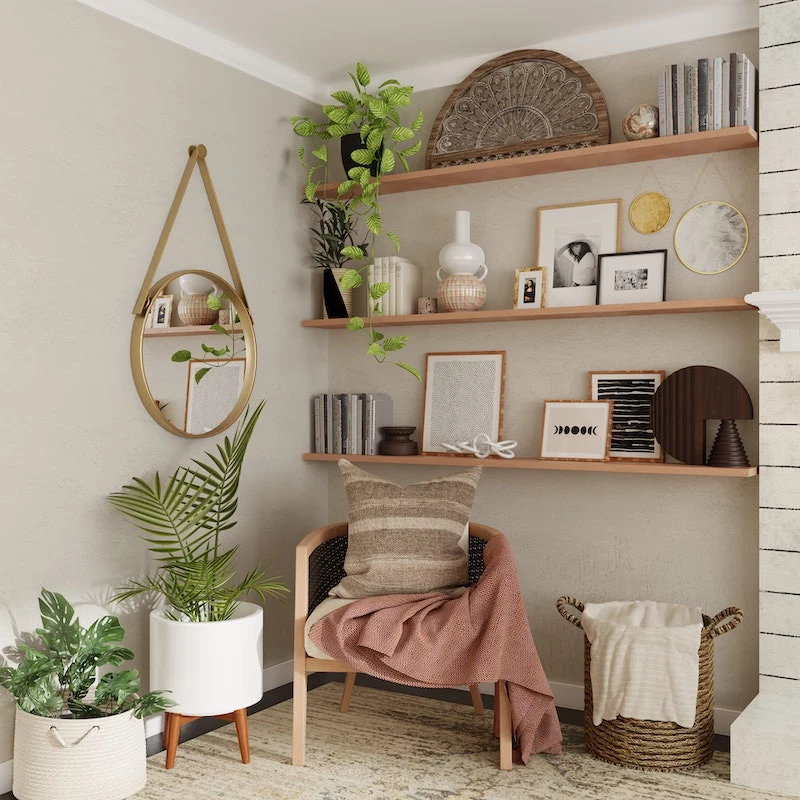
The Art of Arrangement: How the Pros Lay Out a Room
Okay, with your traffic flow mapped out, you can now place your furniture with a real purpose. A well-arranged room is inviting and encourages people to connect. A bad one feels cold and disjointed, no matter how cool the furniture is.
Find (or Create) a Focal Point
Every room needs a center of gravity—that one thing your eye is naturally drawn to. Sometimes it’s built-in, like a fireplace or a huge window with a killer view. If you don’t have an obvious one, you have to create it. A big piece of art, a beautiful media console, or a well-styled bookcase can do the trick. Your main seating should then be oriented around this focal point. It gives the whole room a sense of order.
The Conversation Zone: This Is a Game-Changer
A living room is for… well, living. And that usually means talking with people. I often see sofas and chairs shoved against the walls, all pointing at a TV, with a giant empty space in the middle. This forces everyone to shout across the room. It’s an easy mistake to make!
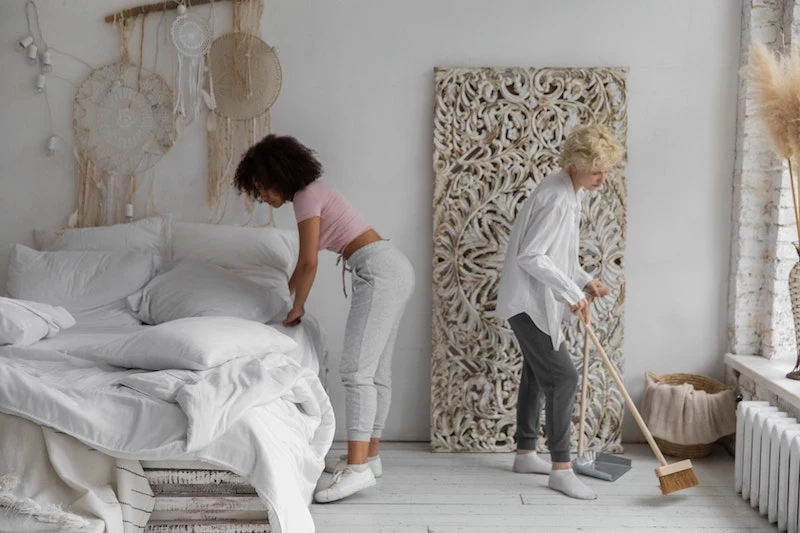
Instead, try this: pull your furniture away from the walls. Yes, even in a small room! Create a cozier, more connected grouping. The sweet spot for distance between a sofa and chairs is about 8 to 10 feet apart, which is perfect for talking at a normal volume. The pieces should generally face each other. Oh, and if the TV has to be the main event? No problem. Try an L-shaped or U-shaped seating arrangement. It allows everyone to see the screen but still turn and talk to each other without feeling like they’re in a movie theater.
Getting Rugs and Tables Right
Area rugs are probably one of the most misused items I see. A tiny rug floating in the middle of a room makes everything look dinky and disconnected. Here are the simple rules I swear by:
- The Front-Legs Rule: At the very least, the front two legs of your sofa and any chairs in the grouping should be sitting on the rug. This anchors the whole conversation area together.
- The All-Legs Rule: For a more luxurious feel in a larger room, get a rug that’s big enough for all four legs of every piece of furniture to rest on it. It really defines the space.
- Quick Sizing Tip: Your rug should stick out at least 6 to 8 inches beyond the sides of your sofa for good visual balance.
By the way, rugs can get pricey. A large, budget-friendly jute or polypropylene rug might run you $200-$400, while a nice wool one could be $800 or more. A lesser-known trick is to buy a large, inexpensive neutral rug (like jute) and then layer a smaller, plusher, more expensive-looking rug on top. You get the size and the style without the massive price tag.
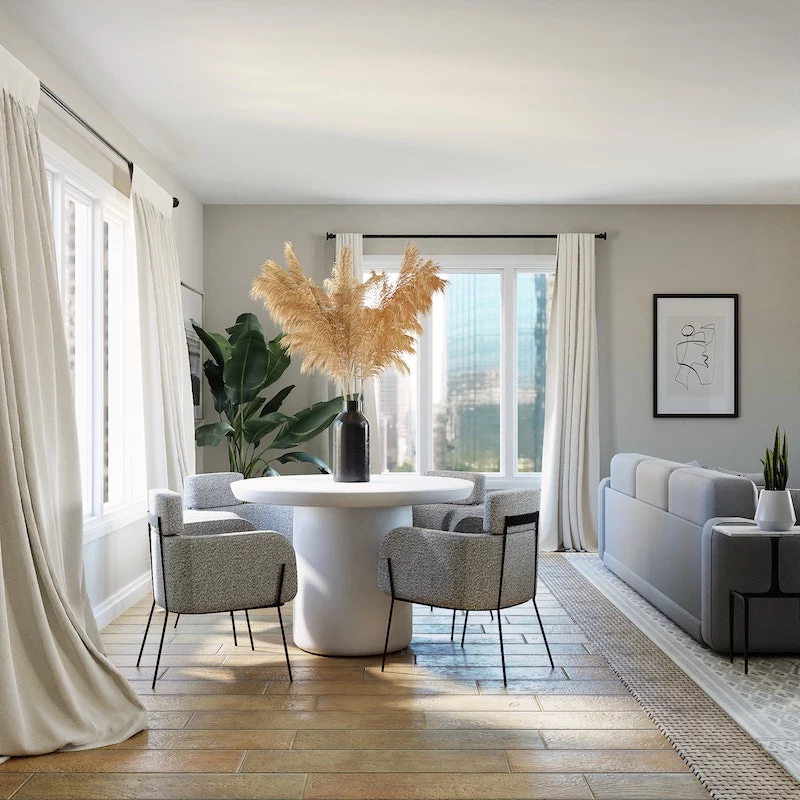
For coffee tables, the magic is in its relationship to the sofa. It should be about the same height as the sofa cushions (give or take an inch or two) and be placed 14 to 18 inches away from the sofa. This is close enough to reach your drink, but far enough for legroom. These aren’t just random numbers; they come from decades of ergonomic study.
Mastering Light and Color: The Vibe-Setters
Light and color are your most powerful tools. They completely change the mood of a space, and getting them right is part science, part art.
The Three Layers of Lighting
One lonely ceiling light just won’t cut it. To make a room feel rich and inviting, you need to think in layers. Here’s a simple starter kit to aim for:
- Ambient Light: This is your general, overall light. It usually comes from a ceiling fixture or recessed lights.
- Task Light: This is focused light for doing stuff. Think of a reading lamp by a chair or an arc lamp over a small table.
- Accent Light: This is the fun stuff! It’s strategic light that highlights things you love, like a small spotlight on a piece of art or uplighting on a big plant. It adds drama and dimension.
Lighting Starter Kit: You can get started for under $100. Grab a pack of ‘Warm White’ (2700K) LED bulbs (~$15), one good-looking floor lamp for task lighting next to your sofa (~$75-$150 from places like Target or Wayfair), and a simple plug-in dimmer for one of your lamps (~$10 at Home Depot). This combo alone will transform the feel of your room at night.
Light Bulb Temperature is Everything
When you buy a light bulb, pay attention to the Kelvin number (K). This measures the color of the light, and it’s critical for mood. A lower number (around 2700K) gives off that warm, yellow, cozy light we all love. A higher number (4000K+) produces a cool, blue-white light that feels more like an office. For a living room, I almost always recommend staying in the 2700K to 3000K range. Using a cool, high-Kelvin bulb can make even the warmest paint color feel sterile.
A Quick Safety Note: Layering light is great, but electricity is no joke. Unless you are a licensed electrician, please don’t try to install new hardwired fixtures yourself. Hiring a pro for a small job like swapping a fixture might cost you between $150 and $300, and it’s worth every penny for safety and peace of mind. Also, be careful not to overload one outlet with a bunch of power strips. If your breakers are tripping, that’s a huge red flag to call an electrician.
Choosing Colors for Your Climate
The same can of paint can look wildly different depending on where you live. It’s all about the quality of the natural light. I once painted a client’s north-facing room a supposedly ‘calm’ light blue, and it ended up looking like a depressing, icy cave. We had to repaint with a color that had warm, yellow undertones to counteract the cool natural light. The opposite is true in super sunny climates, where warm colors can look almost cartoonishly bright. Always, always test a big sample on your wall and look at it at different times of day before you commit.
Solving Those Tricky Room Problems
Not every room is a perfect rectangle. Here’s how to tackle some common challenges.
The Long, Narrow Room: The goal here is to avoid the “bowling alley” look. Don’t just line everything up on the long walls. Instead, break the room into two or more zones. You could have your main seating area at one end, anchored by a rug, and then create a little reading nook or a small desk area at the other end. Using different rugs for each zone is a great visual trick to make the room feel wider and more functional.
The Open-Concept Space: When your living room bleeds into your kitchen, you need to create clear definitions without putting up walls. Furniture is your best friend here. A big sectional sofa with its back to the dining area can create a clear boundary. Rugs are absolutely essential in this setup—they basically draw a line on the floor and say, “This is the living room.”
Hanging Art Like You Know What You’re Doing
You can instantly spot an amateur design by how the art is hung. Most people hang it way too high, so it just floats weirdly above the furniture. Here’s the rule the pros and galleries use: hang art so that its center is 57 inches from the floor. Why 57 inches? It’s the average human eye level, and it ensures the art connects to the room on a human scale instead of feeling detached.
When hanging art over a sofa, the bottom of the frame should be about 6 to 9 inches above the sofa’s back. For a gallery wall, lay all your pieces out on the floor first. Then—and this is the real pro tip—trace each frame onto kraft paper, cut out the templates, and tape them to the wall with painter’s tape. You can move the paper around until it’s perfect, all without making a single mistaken nail hole.
The Final Layers: Bringing It All to Life
Once the big stuff is right, it’s time for the layers that make a room feel personal.
It’s All About Texture: A room where every surface is slick and smooth can feel really cold. You need to mix it up to create depth and comfort. Think about a smooth leather sofa with a chunky wool blanket, or a rough wood coffee table next to a soft velvet chair. This variety is what makes a room feel inviting and lived-in.
Bringing in Plants with Purpose: A bit of greenery is fantastic, but be intentional. Instead of dotting tiny succulents everywhere, think about scale. That empty corner is crying out for a tall fiddle-leaf fig or monstera in a big, substantial pot. And be realistic about light! A plant that needs bright sun will die a slow, sad death in a dark corner. Low-maintenance options like a snake plant or a ZZ plant are super forgiving and great for beginners.
Telling Your Story (Without the Clutter): Your home should be a reflection of you, but that’s not an excuse for clutter. There’s a big difference between a curated collection and just… stuff. To figure it out, try this (it might take a weekend, but it’s transformative): take every single decorative object out of the room. Live with the empty space for a day. Then, start bringing things back in, one by one. Ask yourself, “Do I truly love this? Does it tell a story I care about?” You’ll be shocked by how much you don’t even miss. Then, group similar items together—three vases on a mantle have way more impact than three scattered around the room. This editing process is honestly the most powerful step of all.
Quick Wins: 3 Things to Do This Weekend for Under $50
Feeling overwhelmed? Don’t be. Here are three small things you can do right now to make a big difference.
- Pull Your Sofa Off the Wall: Grab some furniture sliders ($10) and pull your main sofa and chairs 6-8 inches away from the wall to create a more intimate grouping. It instantly feels more professional.
- Change a Light Bulb: Swap the bulb in your main living room lamp for a 2700K ‘warm white’ LED bulb ($5). The difference in the room’s evening glow will astound you.
- ‘Shop’ Your Own Home: Go on a treasure hunt in your own house. Find 3-5 objects of a similar color or material (like blue glass, or wooden objects) and group them together on your mantle or a bookshelf. Instant, free art!
A living room refresh is a journey, for sure. But by using these core principles, you can create a room that not only looks better but just feels right. It’ll be a space that truly serves you and your family for years to come. And hey, if you’re planning on knocking down walls or anything major, that’s the time to call in a certified designer or architect. Their expertise is a smart investment to get it right the first time.
Inspirational Gallery
Once your main pathways are clear, focus on the conversation zones. The distance between your sofa and coffee table is crucial for both function and flow.
- Too close (under 14 inches): It feels cramped, and you can’t walk by.
- Too far (over 18 inches): You can’t comfortably reach for a drink or a book.
The sweet spot? Aim for 16-18 inches. It keeps everything accessible without creating a barrier.
A rug that’s too small is one of the most common living room mistakes. All of your main seating furniture—or at least the front legs of it—should sit on the rug.
This simple rule instantly makes a space feel more cohesive and intentional. When the rug is just floating in the middle with no furniture touching it, it visually shrinks the room and makes the arrangement feel disjointed.
The Wall-Hugger Myth: Many people believe that pushing all furniture against the walls will make a room feel bigger. In reality, it often creates a sterile, impersonal ‘waiting room’ vibe. Pulling your sofa and chairs even a few inches away from the wall creates breathing room and makes the space feel more curated and inviting.
How do designers create that warm, inviting glow?
It’s all about layered lighting. A single overhead fixture is rarely enough and often feels harsh. For a professional feel, combine at least three types of light: ambient (the main overhead or recessed lights), task (a reading lamp by a chair), and accent (a small lamp on a console or an uplight for a plant). For an extra cozy feel, choose bulbs with a warm temperature, typically between 2700K and 3000K.
Focal Point A: The TV. Practical, but it can dominate the room, making conversation secondary. The arrangement naturally orients every seat towards the screen.
Focal Point B: A Fireplace or Art. This encourages social interaction, with furniture arranged to facilitate conversation. A TV can still be present, but it won’t be the primary focus of the room’s layout.
Consider what you want the room’s main purpose to be: media consumption or social connection?
According to environmental psychology, circular or curved furniture arrangements are perceived as more friendly and facilitate conversation more effectively than rigid, linear layouts.
You don’t need a curved sofa to achieve this. Try angling two armchairs towards each other over a shared side table, or slightly turning a sofa to face a pair of chairs. This subtle shift breaks up harsh lines and subconsciously encourages guests to interact.
- It draws the eye upward, creating an illusion of height.
- It adds personality without taking up floor space.
- It balances the visual weight of heavy furniture below.
The secret? Thinking vertically. A common layout mistake is forgetting the walls. A large piece of art hung 57-60 inches on center, or a tall, narrow bookshelf like the Vittsjö from IKEA, can completely transform the feel of a room by adding vertical interest.
Even with a perfect layout, a room can feel flat. The solution is texture. Think about how different materials feel to the touch and to the eye. The smooth coolness of a marble coaster, the nubby weave of a linen pillow from a brand like Parachute, the soft pile of a velvet armchair, and the rustic grain of a wooden bowl. Layering these textures creates a rich, sensory experience that makes a room feel complete and lived-in.
Before you strain your back, play designer on your screen. Free online 3D room planners from brands like West Elm or Pottery Barn let you recreate your living room’s dimensions and drag-and-drop furniture to test different layouts. This is the ultimate pro-level hack to visualize flow and spacing without moving a single heavy object. You can experiment with radical ideas risk-free.






